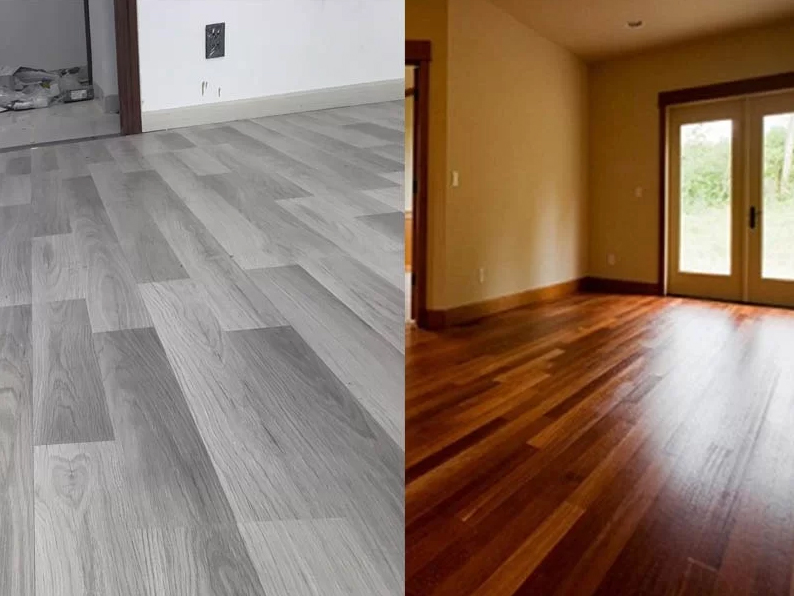Timber flooring has grown in popularity over the years, and why not? Timber is long-lasting, durable, and adds natural textures to your home. When selecting the best timber flooring for your next remodel or build, there are numerous factors to consider.
Solid and engineered timber flooring explores numerous colors and finishes while utilizing genuine timber’s innate warmth and earthy feel. However, they both have advantages and disadvantages, which we will examine below.

WHAT’S THE DIFFERENCE BETWEEN SOLID TIMBER FLOORING AND ENGINEERED TIMBER FLOORING?
The primary distinction between engineered and solid timber flooring is that the first one is warrantied and pre-finished, requiring no acclimation, sanding, or staining after laying.
WHAT EXACTLY IS ENGINEERED WOOD FLOORING?
Engineered timber flooring is a multi-layered floor with a surface layer of timber veneer sitting over a multi-ply base.
The top layer of the this kind is around 3-5mm thick, making it more straightforward to age and condition the wood and limiting expansion and contraction, but it can still be sanded and refinished like solid wooden flooring. It enables a manufacturer to create a pre-finished floorboard that does not require additional sanding or polishing after installation; additionally, You can supply the wood, laid, and ready to go all in the same day.
HOW LONG WILL ENGINEERED WOOD FLOORING LAST?
Engineered flooring can endure anywhere from 20 to 30 years when maintained adequately. When properly cared for, timber flooring can last for 10-12 years before needing to be re-sanded.
WHAT ARE THE ADVANTAGE OF ENGINEERED WOOD FLOORING?
Engineered Timber Flooring is an excellent alternative to natural hardwood flooring since it is less expensive, easier to install, and, most significantly, comes in a variety 100s of contemporary colors and finishes to brighten any home. Furthermore, once placed, it isn’t easy to discern from solid timber flooring.
- Other advantages of engineered wood flooring include the following:
- (As previously said) It is less expensive than solid hardwood flooring.
- Once laid, it isn’t easy to distinguish from solid flooring.
- Better resistance to temperature and humidity variations than solid wood flooring
- Significantly more consistent
- Pre-finished wood flooring
- Coating with a matte finish
- Overheat solar floors can be built
- There are numerous wood types, styles, colors, and finishes.
- If necessary, the top layer can be sanded and refinished.
- Installation time is reduced.
- Environmentally conscious
Engineered floorboards are built on a multi-layer ply base. It improves the floorboards’ stability and significantly reduces the likelihood of the wood cupping or shrinking over time.
Engineered floorboards are coated in the factory using a selective color-matching process in a controlled environment. It gives customers the assurance they require when ordering oak timber floorboards.
Our matt finish coating greatly reduces the dust on your floorboards. It enables homeowners to do spot repairs on their floorboards rather than waiting to fully re-sand and recoat them, which is the only way to repair solid timber floorboards.
WHAT ARE THE DRAWBACKS OF ENGINEERED WOOD FLOORING?
No flooring is without flaws, and while we are strong supporters of engineered wood flooring, there are some drawbacks to the material that must be considered.
It is susceptible to fading if exposed to direct sunlight; however, oak flooring dramatically reduces this risk. Water resistance is slightly lower.
WHAT EXACTLY IS SOLID TIMBER FLOORING?
Solid timber flooring is a classic hardwood floor made entirely of wood. Solid wood flooring is frequently laid in its raw state, which means the wood will need to be sanded and polished after installation.
Solid wood flooring has no warranty and must be acclimatized in houses for several weeks before installation. They had to be sanded and coated on-site, which added weeks to the time it took to walk on the flooring.
HOW LONG WILL SOLID WOOD FLOORING LAST?
The lifespan of solid wood flooring is primarily determined by how well your floors are cared for. When done correctly, your flooring can survive for almost 40 years.
WHAT ARE THE ADVANTAGE OF SOLID WOOD FLOORING?
As previously said, one of the most significant advantages of solid wood flooring is the possibility to sand the floors 3-4 times.
- Other advantages of solid wood flooring include the following:
- It can be utilized as a subfloor when laid over bearers and joints.
- After all, trades are completed, the surface is sanded and coated.
WHAT ARE THE DRAWBACKS OF SOLID WOOD FLOORING?
As previously stated, no flooring is without flaws, even solid wood flooring, which we’ve listed below:
- High gloss that might show dirt and dust and necessitates additional cleaning
- High gloss flooring might be more difficult to restore and require more maintenance than constructed floorboards.
- It is less stable than engineered wood flooring.
- Thinner board sizes can contribute to clutter in the home.
- Installation time can range from 4-6 weeks.
- Longer wait time: Solid floorboards must be acclimatized in the home for approximately six weeks before being installed, coated, and fully cured before homeowners can move in.
- There is a limited selection of colors available.
- A more expensive option
The best timber flooring for you ultimately depends on personal preference and functionality. With many years of flooring industry experience, our team of experts is here to assist you in selecting timber flooring that meets your needs.


